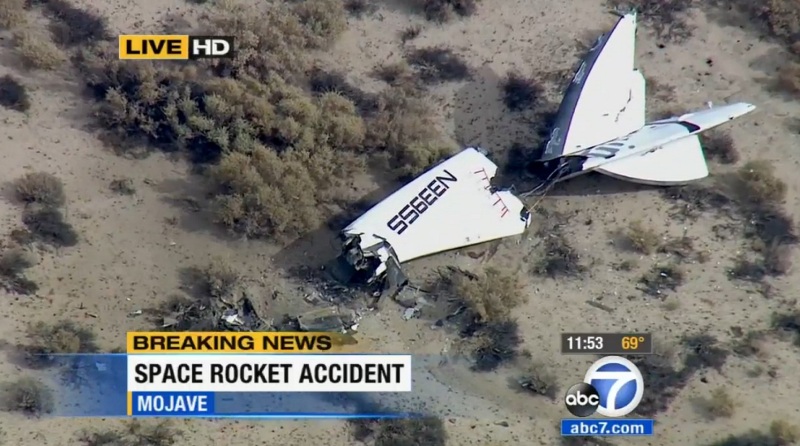Kevin Mickey, president of Scaled Composites, the company that's developed SpaceShipTwo, downplayed speculation about the fuel's role in Friday's incident.
"We were flying a rocket motor today that had been thoroughly tested on the ground and we expected no anomalies with the motor," Mickey said.
Witt said that prior to the flight, "I was briefed that the plume would look different than in the past, but I couldn’t detect anything." However, he added that because of "what I wasn’t hearing or seeing," he could tell the flight was not proceeding normally. He added that he had not seen the vehicle explode.
Ken Brown, a freelance photographer who was covering the flight, told the Associated Press and NBC News that he saw the craft blow apart after its engine was lit.
Kern County Sheriff Donny Youngblood said that he had flown to the crash site immediately.
"It’s a large area, the aircraft is in several different pieces," Youngblood said. "We found one person who was obviously deceased. I don’t have condition of the other person -- it appears to be major injuries, but we don't know what that means yet."
The survivor was hospitalized at Antelope Valley Hospital in Lancaster. Neither crewmember was identified; both were Scaled Composite test pilots.
SpaceShipTwo is part of a two-aircraft system: Its mother ship, called the WhiteKnight2, carries the six-passenger spaceship to an altitude of about 50,000 feet, then releases it. Pilots on the spacecraft then ignite its rocket motor, which is designed to propel the ship at more than three times the speed of sound to an altitude of 100 kilometers or so — about 62 miles, considered the threshold of space.
The winged spacecraft is designed to make a “feathered re-entry” into the atmosphere and an unpowered glide back to its takeoff point.
The ship is based on a design by aircraft designer Burt Rutan, perhaps best known for developing the Voyager, a spindly featherweight plane that in 1986 completed a round-the-world flight without refueling.
With backing from technology billionaire Paul Allen, Rutan's Scaled Composites built SpaceShipOne in an attempt to win the $10 million Ansari X Prize, a competition to create a rapidly relaunchable craft that could carry at least three people into suborbital space. SpaceShipOne successfully completed its repeat flights in October 2004, winning the prize. Richard Branson, chief of the Virgin entertainment and aviation empire, then invested in SpaceShipTwo as a space tourism vehicle and launched a new enterprise to operate flights, Virgin Galactic.
The fare for a trip to the edge of space -- an adventure that would include several days of preflight training at a new spaceport in New Mexico and perhaps a few minutes in a zero gravity environment during the flight -- is $250,000. The company has said more than 700 people have booked flights, which were scheduled to begin as early as next year.
George Whitesides, Virgin Galactic's CEO, said Branson was traveling to Mojave and is expected to arrive Saturday. He and Witt, the Mojave space port manager, both put Friday's incident in the larger context of the quest to expand space exploration.
"Space is hard, and today was a tough day," Whitesides said. "We are going to be supporting the investigation as we figure out what happened today and we’re going to get through it. The future rests in many ways on hard days like this and we believe we owe it to the folks who were flying these vehicles as well as the folks who’ve been working so hard on this, to understand this and to move forward, which is what we’ll do."
Industry observers agree that Friday's accident is a reversal for space tourism. From the AP:
"I think it's a real setback to the idea that lots of people are going to be taking joyrides into the fringes of outer space any time soon," said John Logsdon, retired space policy director at George Washington University. "There were a lot of people who believed that the technology to carry people safely at hand."
And from The New York Times:
“Virgin was out ahead of everyone else for space tourism,” said Michael Blades, the aerospace and defense industry senior analyst at Frost & Sullivan, a market research and consulting firm. “It will still happen, but it has been pushed way to the right. It is just like any kind of other new technology, especially when it comes to flight, you have your tests and you have your failures.”
Patricia Hynes, director of the New Mexico Space Grant Consortium, who organizes an annual symposium for people in the commercial space industry, said the accident “helps people understand why it’s never been done before.”
“This is a tough business,” she said.
Dr. Hynes has bought a Virgin Galactic ticket, and the news did not change her intention to fly. “No, absolutely not,” she said.
